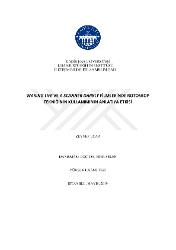| dc.contributor.advisor | Selen, Eser | en_US |
| dc.contributor.author | Uçar, Zeynep | |
| dc.date.accessioned | 2020-02-16T14:52:43Z | |
| dc.date.available | 2020-02-16T14:52:43Z | |
| dc.date.issued | 2019 | |
| dc.identifier.uri | https://hdl.handle.net/20.500.12469/2744 | |
| dc.description.abstract | 1915 yılında Max Fleischer tarafından geliştirilen ve günümüzde hem elde hem de dijital olarak üretimi sürdürülen rotoskop tekniği, oyuncunun filme alınmış performansının projeksiyon yardımıyla cam bir yüzeyin arkasına yansıtılarak tek seferde tek kare olmak üzere görüntünün üzerinden elde çizim yapılmasına olanak tanıyan bir yöntemdir. Yöntem, diğer tekniklerden hareketin çizgi karaktere kopyalandığı süreçte fotoğrafik görüntünün çizgisel form ile bastırılması yoluyla ayrışmaktadır. Bu durum, görüntünün varlık-yokluk, gerçeklik- temsil, görüntülenen öznenin yahut animatörün varlığı gibi ikilikler arasındaki gerilimden beslenerek muğlak bir görsel izlenim yaratmasına neden olmaktadır. Ayrıca, yöntem, animasyonun erken dönemlerinde, tekniğin ontolojisi göz önünde bulundurulmaksızın, yalnızca hareket kesitleri arası geçişin akışkan ve gerçekçi bir biçimde gerçekleşmesini sağlamak için kullanılmıştır. Bu nedenle dijital çağa geçilmesi ile birlikte haraket yakalama [motion capture] gibi tekniklerin kullanılmaya başlamasıyla yalnızca rotoskop tekniği kullanılarak üretilen animasyon sayısında düşüş gözlenmektedir. Buradan hareketle, dijital çağa geçilmesinden itibaren yalnızca rotoskop tekniği kullanılan animasyonlar, tekniğin ontolojisini anlam yaratmaya yönelik bir biçimde kullanmaya başlamışlardır. Waking Life (Linklater, 2001) ve A Scanner Darkly (Linklater, 2006) gibi rotoskop tekniğini kullanan ve karakterlerin uyuşturucu ve rüyalar dolayımıyla içinde bulundukları gerçeklik ile olan ilişkilerini merkezine alan animasyonların, anlatılarında, görüntünün kullanmakta olduğu fotoğrafik imge ile olan ilişkisinden, algısal alana dair ve çizgisel olanın bir arada bulunmasının sağladığı muğlak izlenimden yararlanılmaktadır. Bu ilintiden yola çıkılarak yapılacak araştırmanın amacı rotoskop tekniğinin algı ile nasıl bir ilişki kurduğunu ve bahsi geçen filmlerin anlatısında sinemanın deneyim ile ilişkisi üzerine ne gibi söylemler üretilmesini sağladığını, Maurice Merleau-Ponty, Andre Bazin, Walter Benjamin gibi kuramcıların imge üzerine teorileri doğrultusunda kavramaktır. | en_US |
| dc.description.abstract | Developed by Max Fleischer in 1915, rotoscoping is an animation technique which allows the
artist to draw and duplicate the actor’s performance which is reflected on a transparent surface
frame by frame. The technique differs from other animation techniques by the repression of
the photographic image by a sketched form, during the process of duplication of the
movement to the sketched character. This situation causes the image to create an ambiguous
visual impression provoked by the tension between absence-presence, reality-representation,
actor-animator dynamics. In early periods of animation, rotoscoping was used to ease the
transition of the movement between sequential frames, regardless of its formal and
ontological features. Correspondingly, a decrease is observed in the usage of rotoscoping in
the digital era, after the invention of new techniques such as motion capture. The animations
that use rotoscoping after digitalization mostly aim to use the technique to create meaning
considering its form features. Rotoscoped animations which focus on personal realities of
characters who are experiencing dreams or hallucinations, including Waking Life (Linklater,
2001) and A Scanner Darkly (Linklater, 2006), benefit from the ambigious characteristics
derived from the coexistence of the linear image and the perceptional ground of photographic
cinema. The objective of this research is to figure out how rotoscoping relates to perception
and what kind of statements are provided by the use of the technique, utilizing the ideas and
writings of theoreticians such as Maurice Merleau-Ponty, Andre Bazin and Walter Benjamin | en_US |
| dc.language.iso | tur | en_US |
| dc.publisher | Kadir Has Üniversitesi | en_US |
| dc.rights | info:eu-repo/semantics/openAccess | en_US |
| dc.subject | Rotoskop | en_US |
| dc.subject | Sinema | en_US |
| dc.subject | Fotoğraf | en_US |
| dc.subject | Resim | en_US |
| dc.subject | Belirti | en_US |
| dc.subject | Hareket | en_US |
| dc.subject | Zaman | en_US |
| dc.subject | Deneyim | en_US |
| dc.subject | Algı | en_US |
| dc.subject | Rotoscoping | en_US |
| dc.subject | Cinema | en_US |
| dc.subject | Photograph | en_US |
| dc.subject | Painting | en_US |
| dc.subject | Index | en_US |
| dc.subject | Movement | en_US |
| dc.subject | Time | en_US |
| dc.subject | Experience | en_US |
| dc.subject | Perception | en_US |
| dc.title | Waking Life ve a Scanner Darkly filmlerinde rotoskop tekniğinin kullanımının anlatıya etkisi | en_US |
| dc.title.alternative | Narrative effects of rotoscoping in Waking Life and a Scanner Darkly | en_US |
| dc.type | masterThesis | en_US |
| dc.department | Enstitüler, Lisansüstü Eğitim Enstitüsü, İletişim Bilimleri Ana Bilim Dalı | en_US |
| dc.relation.publicationcategory | Tez | en_US |
| dc.identifier.yoktezid | 554267 | en_US |
















